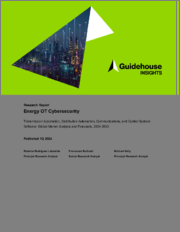
유틸리티 기업들은 중요 인프라에 연결성을 추가하여 친환경 이니셔티브를 촉진하고, 복원력을 향상시키며, 장애 복구를 용이하게 하는 등 다양한 혜택을 누리고 있습니다. 그러나 연결성이 증가함에 따라 공격 대상도 확대되어 악의적인 행위자가 데이터를 훔치거나 유틸리티 기업의 장비를 파괴할 수 있는 기회가 많아졌습니다. 이에 따라 유틸리티 기업 내 운영 기술(OT) 조직은 IT 부서를 따라 사이버 공격으로 인한 피해를 줄이기 위해 더 높은 수준의 사이버 보안 관리를 수행해야 하는 상황에 직면하게 되었습니다.
동시에 제조업과 유틸리티와 같은 부문에 대한 사이버 공격은 최근 몇 년 동안 급증하고 있으며, 더욱 교묘해지고 있습니다. 사이버 보안 연구자들은 끊임없이 새로운 위협 그룹과 취약점을 발견하는 한편, 공격자들은 끊임없이 돈을 갈취하고 업무를 방해하는 새로운 방법을 고안하고 있습니다. 예를 들어, 연구진에 따르면 2023년 랜섬웨어 공격의 총액이 처음으로 10억 달러를 돌파할 것이라고 합니다. 이는 공격자들이 더 많은 공격을 하고 한 번의 공격으로 더 많은 돈을 요구했기 때문입니다.
이 보고서는 에너지 산업의 OT 분야, 특히 송전 자동화, 배전 자동화, 통신 및 산업 제어 시스템 분야의 사이버 보안에 초점을 맞추고 있습니다. 사이버 공격을 방지하고 완화하기 위한 기술 및 전술의 현황을 논의하고, 전 세계 에너지 산업의 OT 사이버 보안 지출에 대한 예측을 제시합니다.
Adding connectivity to critical infrastructure has enabled utilities to implement green initiatives, improve resilience, and manage faults more easily. However, increased connectivity has also expanded the attack surface for malicious actors to steal data or wreck utilities' equipment. As a result, operational technology (OT) organizations within utilities have had to follow their IT colleagues in implementing greater cybersecurity controls to reduce the damage from cyberattacks.
At the same time, cyberattacks against sectors like manufacturing and utilities have grown sharply in recent years and are becoming more sophisticated. Cybersecurity researchers continually discover new threat groups and vulnerabilities, and attackers constantly devise new ways to extort money or disrupt operations. For example, researchers say that in 2023, ransomware attacks totaled more than $1 billion for the first time, as threat actors launched more attacks and demanded more money per attack.
This report focuses on cybersecurity in the energy OT sector, specifically in the areas of transmission automation, distribution automation, communications, and industrial control systems. It discusses the state of play in terms of technologies and tactics to prevent and mitigate cyberattacks, and presents forecasts for energy OT cybersecurity spending in all world regions.